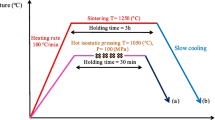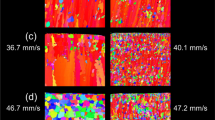Abstract
Selective laser melting (SLM) has been shown to be an attractive manufacturing route for the production of α/β titanium alloys. The relationship between the SLM process parameters and the microstructure of titanium alloys has been the object of several works, but the texture formation during the SLM process has yet to be understood. In the present study, the texture formation of Ti-6Al-4V components was investigated in order to clarify which microstructural features can be tailored during the SLM process. The microstructural characterization of the as-built components was carried out using various microscopy techniques. Phase and texture analysis were carried out using backscattered electron imaging and diffraction. It was found that as-built components consist exclusively of α′ martensitic phase precipitated from prior β columnar grains. The texture of the prior β phase was reconstructed and discussed in relation to the used SLM process parameters. It was found that the β grain solidification is influenced by the laser scan strategy and that the β phase has a strong 〈100〉 texture along its grain growth direction. The α′ martensitic laths that originate from the parent β grains precipitate according to the Burgers orientation relationship. It was observed that α′ laths clusters from the same β grain have a specific misorientation that minimizes the local shape strain. Texture inheritance across successive deposited layers was also observed and discussed in relation to various variant selection mechanisms.










Similar content being viewed by others
References
M. Baumers, C. Tuck, R. Wildman, I. Ashcroft, and R. Hague: Proceedings of the Solid Freeform Fabrication Symposium, 2011.
C. Tuck, R. Hague, N. Burns: International Journal of Services and Operations Management, 2007, vol. 3, pp. 1-22.
L. Murr, S. Quinones, S. Gaytan, M. Lopez, A. Rodela, E. Martinez, D. Hernandez, F. Medina, R. Wicker: J Mech Behav Biomed, 2009, vol. 2, pp. 20-32.
A. Gebhardt, F. Schmidt, J. Hötter, W. Sokalla, P. Sokalla: Phys. Procedia, 2010, vol. 5B, pp. 543–49.
E. Chlebus, B. Kuznicka, T. Kurzynowski, B. Dybala: Mater Charact, 2011, vol. 62, pp. 488-495.
L. Facchini, E. Magalini, P. Robotti, A. Molinari, S. Hoeges, K. Wissenbach: Rapid Prototyping J., 2010, vol. 16, pp. 450-459.
B. Vrancken, L. Thijs, J.P. Kruth, J.V. Humbeeck: J Alloy Compd, 2012, vol. 54, pp. 177-185.
T. Sercombe, N. Jones, R. Day, A. Kop: Rapid Prototyping J., 2008, vol. 14, pp. 300-04.
L. Thijs, F. Verhaeghe, T. Craeghs, J.V. Humbeeck, J.P. Kruth: Acta Mater 2010, vol. 58, pp. 3303-3312.
D. Gu, Y. Hagedorn, W. Meiners, G. Meng, R.J.S. Batista, K. Wissenbach, R. Poprawe: Acta Mater., 2012; vol. 60, pp. 3849-3860.
T. Vilaro, C. Colin, J.D. Bartout: Metall. Mater. Trans. A, 2011, vol. 42, pp. 3190-3199.
B. Song, S. Dong, B. Zhang, H. Liao, C. Coddet: Mater Des 2012, vol. 35, pp. 120-125.
B. Baufeld, O.V. Biest: Sci Tech Adv Mater, 2009, vol. 10, 015008.
B. Baufeld, E. Brandl, O.V. Biest: J Mater Process Technol, 2011, vol. 211, pp. 1146–1158.
S. Al-Bermani, M. Blackmore, W. Zhang, I. Todd: Metall. Mater. Trans. A, 2010, vol. 41, pp. 3422-3434.
S. Kelly, S. Kampe: Metall. Mater. Trans. A, 2004, vol.35, pp. 1861-1867.
L. Zhang, D. Klemm, J. Eckert, Y.Hao, T. Sercombe: Scr Mater, 2011, vol. 65, pp.21-24.
T. Vilaro, V. Kottman-Rexerodt, M. Thomas, C. Colin, P. Bertrand, L. Thivillon, S. Abed, V. Ji, P. Aubry, P. Peyre, T. Malot: Adv Mat Res, 2010, vol. 89-91, pp. 586-591.
G.C. Obasi, S. Birosca, D.G. Leo Prakash, J. Quinta da Fonseca, M. Preuss: Acta Mater, 2012, vol. 60, pp. 6013-6024.
G.C. Obasi, S. Birosca, J. Quinta da Fonseca, M. Preuss: Acta Mater, 2012, vol. 60, pp. 1048-1058.
M. Humbert, F. Wagner, H. Moustahfid, C. Esling: J Appl Cryst, 1995, vol. 28, pp. 571-576.
M. Humbert, N. Gey, J. Muller, C. Esling: J Appl Cryst, 1996, vol. 29, pp. 662-666.
M.G. Glavicic, P.A. Kobryn, T.R. Bieler, S.L. Semiatin: Mater Sci Eng A, 2003, vol. 351, pp. 258-264.
M.G. Glavicic, P.A. Kobryn, T.R. Bieler, S.L. Semiatin: Mater Sci Eng A, 2003, vol. 346, pp. 50-59.
M. Simonelli, C. Tuck, Y.Y. Tse: J Phys Conf Ser, 2012, vol. 371(1):012084).
Renishaw Apply Innovation, 2012. http://www.renishaw.com/en/am250-laser-melting-machine--15253. Accessed Feb 2014.
M. Simonelli, Y.Y. Tse, and C. Tuck: Proceedings of the Solid Freeform Fabrication Symposium, 2012.
I. Lonardelli, N. Gey, H. Wenk, M. Humbert, S.C. Vogel, L. Lutterotti: Acta Mater, 2007, vol. 55, pp. 5718-5727.
M.R. Daymond, R.A. Holt, S. Cai, P. Mosbrucker, S.C. Vogel: Acta Mater, 2010, vol. 58, pp. 4053-4066.
R. Boyer, E.W. Collings, Materials Properties Handbook: Titanium Alloys, ASM International, Materials Park, OH, 1994; pp. 483–633.
I.A. Roberts, C.J. Wang, R. Esterlein, M. Stanford, D.J. Mynors: Int J Mach Tool Manu, 2009, vol. 49, pp. 916-923.
M.G. Glavicic, P. Kobryn, S.L. Semiatin: Mater Sci Eng A, 2004, vol. 385, pp. 372-376.
P. Kobryn, S.L. Semiatin: J Mater Process Technol., 2003, vol. 135, pp. 330-339.
B. Baufeld, O.V. Biest, S. Dillien: Metall Mater Trans A, 2010, vol. 41, pp.1917-1927.
S.C. Wang, M. Aindow, M.J. Starink: Acta Mater, 2003, vol. 51, pp. 2485-2503.
D. Bhattacharyya, G. Viswanathan, R. Denkenberger, D. Furrer, H.L. Fraser: Acta mater, 2003, vol. 51, pp. 4679-4691.
D. Bhattacharyya, G.B. Viswanathan, H.L. Fraser: Acta Mater, 2007, vol. 55, pp. 6765-6778.
N. Stanford, P.S. Bate: Acta Mater, 2004, vol. 52, pp. 5215-5224.
M. Humbert, L. Germaine, N. Gey, P. Bocher, M. Jahazi: Mater. Sci. Eng. A, 2006, vol. 430, 157–164.
G.A. Sargent, K.T. Kinsel, A.L. Pilchak, A.A. Salem, S.L. Semiatin: Metall. Mater. Trans. A, 2012, vol. 43, pp. 3570-3585.
Author information
Authors and Affiliations
Corresponding author
Additional information
Manuscript submitted October 3, 2013.
Appendix A
Appendix A
One method to express the 3D orientation of a crystal is to define the rotation of the crystal coordinate system relative to the sample coordinate system and consider the symmetry of the crystal itself. The rotation of the crystal is generally described by a triplet of angles, known as Euler angles, (φ 1, Φ, φ 2), that express the consecutive rotations about the axis of the crystal coordinate system that are needed to bring the crystal coordinate system into coincidence with the sample coordinate system (i.e., passive rotations). In the present study a crystal coordinate system for the α and β phases was chosen as defined in the software OIM TM 5.2 of the EDAX-TSL system. The 3D rotations were then expressed according to the Bunge’s convention as follow:
Because of the crystal symmetry however, multiple rotations can result in an equivalent 3D orientation of a certain crystal. For this reason, it was also necessary to take into account the rotational symmetry elements of α and β phases in order to be able to distinguish independent orientations. The rotational symmetry elements of the α and β phases (12 and 24, respectively) used in this study are listed in the form of rotational matrices (Bunge’s convention) in Tables I and II.[22] As the α and β phases are related through the Burgers orientation relationship which is equivalent to a Bunge’s rotation expressed by the matrix D (135, 90, 325 deg), it has been shown that starting from three α grain orientations it is possible to the determine the parent β grain orientation with accuracy and conversely each β grain can generate 12 distinct α grain orientations (α variants).[21,22] In the present study, the 12 α variants generated from one single β grain correspond to the set of rotations listed in Table III.
Rights and permissions
About this article
Cite this article
Simonelli, M., Tse, Y.Y. & Tuck, C. On the Texture Formation of Selective Laser Melted Ti-6Al-4V. Metall Mater Trans A 45, 2863–2872 (2014). https://doi.org/10.1007/s11661-014-2218-0
Published:
Issue Date:
DOI: https://doi.org/10.1007/s11661-014-2218-0




